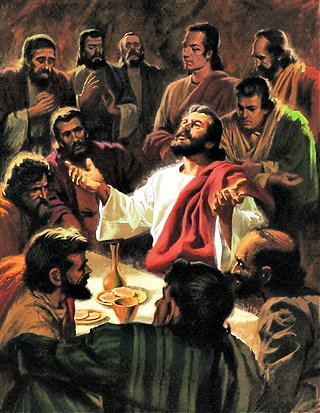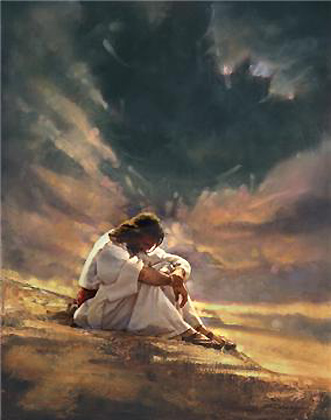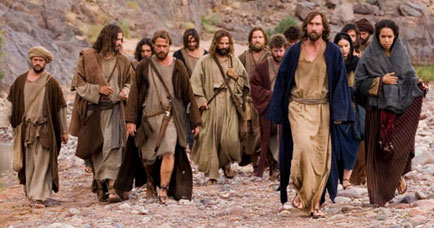 John 17 – Let Us Pray
John 17 – Let Us Pray

The Upper Room Discourse is about to be concluded. The Lord now invites the disciples to leave the Upper Room and go for a walk down to the Kidron valley and up onto the Mount of Olives. They are accustomed to the Lord favoring that area where He would often stay when visiting Jerusalem. Either before they leave, or as they walk along, the Lord says “Let us Pray”. While many refer to Matthew 6:9-13 as “The Lord’s Prayer”, this prayer in John 17 is known as Jesus’ “High Priestly Prayer”. Keep in mind the personal time that Jesus has just spent with His close disciples. Think about the important spiritual truths He has been teaching as He sought to comfort them regarding the important things that were about to happen. It is reasonable that one of the last personal expressions by Jesus with His disciples is this very personal prayer. Prayer has been shown throughout the Gospels to be a key activity for the Lord. Further, this prayer becomes a substantial foundation for the Apostles’ faith, and finds great resolution in much of what is found in the book of Hebrews.
 John 17 – Jesus and the Father
John 17 – Jesus and the Father
Jesus mentions God, His Father, 120 times in John’s Gospel, more than 50 times just in John 13-17, and 5 times in John 17. In his Gospel, John thoroughly expresses the love and deep connection Jesus had with His Father. Nowhere is that more evident than in Jn. 17, as is fitting as Jesus and His Father have been active together as one throughout His public earthly ministry, and now that ministry is concluding. Jesus addresses His Father in the first verse and “His name” in the last verse, and that emphasis underscores the significance as Jesus completes His Father’s mission and He expresses resolve in this prayer for that fulfillment.
Jesus knew the Father intimately as taught in Hebrews 1:1-4, He revealed the Father’s nature. The work He accomplished according to that passage in Hebrews has been very evident in our study of John. It is sobering and special to hear these words that express Jesus’ deepest heart for His Father and the mission He has been accomplishing.
This prayer is different from the prayer He offers later in the Garden of Gethsemane. This prayer is conversational, oriented to relationship and the manifestation of care and purpose – a personal view of His divinity. The “High Priestly” prayer in the Garden is private and emotional, full of personal anguish – perhaps a look at His humanness. As Jesus prays, He has three overriding themes that will show throughout:
-
- Intimacy with the Father
- The Security of our salvation
- Our Purity in the world
 Jesus Prays For Himself – John 17:1-6
Jesus Prays For Himself – John 17:1-6
A prayer for troubled hearts – Jesus prayed regarding “these things” , a key phrase used 33 times in John. This is a simple Greek pronoun, and a favorite reference by John, thinking of the broad scope of all the various “things” which ca![]() me to be resolved in the “eternally weighty things” Jesus spoke and did during His earthly ministry. Jesus is still teaching the Apostles in the Upper Room, as He had been doing since Jn.13, but He is transitioning to a personal ministry to the men’s hearts. This prayer concludes His private ministry with the Apostles and is likely preparation for them to leave the Room and walk towards the Mount of Olives. This prayer is distinct from the prayer which He offers in the Garden before He is arrested.
me to be resolved in the “eternally weighty things” Jesus spoke and did during His earthly ministry. Jesus is still teaching the Apostles in the Upper Room, as He had been doing since Jn.13, but He is transitioning to a personal ministry to the men’s hearts. This prayer concludes His private ministry with the Apostles and is likely preparation for them to leave the Room and walk towards the Mount of Olives. This prayer is distinct from the prayer which He offers in the Garden before He is arrested.
The Main Points of the prayer:
Jesus’ Glorification – Jesus speaks of how He glorified His Father while on earth. It is also an important fact about the Lord Jesus that when He was resurrected, He ascended into heaven and sat at the right hand of the Father. His glorification was established – He returned to His former glory which He had set aside to be our Redeemer (Phil. 2:6-9).
-
- He manifested the Father to those whom God had given Him.
- He was faithful to His task – Jesus gathered (redeemed) them.
- This chapter becomes an important transition for John’s Gospel. Jesus now expresses His High Priestly, intercessory ministry (Heb. 7:25) and focuses on completing the Father’s mission of Redemption.
This prayer becomes a “summary view” of John’s whole gospel. Jesus’ perspective throughout the prayer is being on the other side of the Cross with His mission completed. His prayer is for true believers – He came “that you (us) might belie ve”. His death is His exaltation, Jn.13:31-32. He is the Overcomer, Jn.16:33. The “hour” has come, there are no surprises, He is not being overtaken by circumstances.
ve”. His death is His exaltation, Jn.13:31-32. He is the Overcomer, Jn.16:33. The “hour” has come, there are no surprises, He is not being overtaken by circumstances.
John 17:4-5, The Glory of the Father – Jesus’ life purpose was the Father’s glory. Whatever is yet to be done is assumed completed here. Christ will be reestablished to His former glory (Phil. 2:5-8; Heb. 12:2, He will be seated at God’s right hand. This will be the fulfillment of the “kenosis” (God became Man, Phil. 2:5-8), Jesus will be glorified and this will bring more glory to the Father.
Jesus Prays for His Disciples – John 17:6-19
In John 17:6-10, Jesus declares the Father’s Mission is Accomplished:
-
- 6, Jesus Revealed the Father to the disciples – they belonged to God
- 7-8, Jesus gave them His Word
- 10, He in turn is glorified in the disciples by the Father
These verses sum up His whole ministry. Even before creation, Jesus’ disciples belonged to God (Jn. 6:37). Their names were already in the book of life. In the same way, in Acts 18:10, the Lord told Paul that there were many in Corinth whose names were in the Book but had not yet received Christ, they were already “His”.

Jesus declares “All I have and am, I have from You” (v. 7). This is not the romanticized Galilean Jesus that some today like to imagine, it is the Son of the Holy God Who is my Savior. The Name sums up everything about God (Exo. 3:13-15; Isa. 52:6). Jesus manifested, He gave a complete revelation of God (Heb. 1, Jn. 1, Col. 1).
In v.8, Jesus speaks of how the Father and Son enjoyed direct communication, the authoritative words of God (compare v.14). But more than the spoken word, Jesus Christ was the “Living Word”. By inspiration, in comparison, we also have the “Written Word” of God. The disciples received and believed the words of God – a work we know to be of the Holy Spirit (Jn. 16:13) in the their hearts, and in ours as well. The act of giving is mentioned several times in this prayer – giving results in sacrifice, treasuring, commitment. Note that “eternal life” is also mentioned often in John – 15x during Jesus public ministry through John 12, then 2x in Jn. 17.
In v.9, Jesus prayed for Disciples. But in v.10, He extends His praye to for all us today, as we read in 1 Jn. 2:1; Heb. 7:25. Jesus declares that “they” are the Father’s, and He prays that the Father would “keep” them. Through v.16, this theme of God “keeping” His chosen safe is maintained. Recall how Jesus said that no one can snatch a believer out of His hand (Jn. 10:28). This demonstrates believers being eternally secure in their relationship as God’s children.
In verses16-19, Jesus emphasizes that sanctification is the key, that is our staying unstained by the world’s sin. Just like the priests of the Temple, Christ’s followers are to be “holy to the Lord”, distinctly set aside for God’s use. We are “in the world but not of it”. The instrument of sanctification, according to v. 17 is God’s written Word, and we know from John 16 that it is work of the Holy Spirit to illuminate (help us to understand and apply) the Word to our lives. Verse 19 reminds us that Jesus is our example, that we should walk in His steps (1 Pet. 2:21).
Jesus Prays For All Believers – John 17:20-26
John 17:20, Jesus steps aside from petitioning the Father for the disciples and expands His prayer as only the omniscient God is able, praying now for all those who will believe, not “for these only (ESV)”. We now realize that all the content of this prayer is for all believers of all time. This is a characteristic expression of Jesus’ overall mission – He died for the sins of the whole world (1 Jn. 2:1-2).
John 17:21, Jesus prays for all believers to have a unity in their faith, “…that they may all be one”. Unity is key theme, as it is in Jesus’ entire ministry. Just as the Trinity is a unity – the Father, Jesus Christ and the Holy Spirit (Jn. 14:23; Eph. 4:4-6), so the Church should have an extension of that unity. Biblical unity is built on the revealed Truth of the Bible. Knowing Truth is key – John focused on the theme of “truth” (it is mentioned 90x in his Gospel, while only 70x in all three of the other Gospels). Unity is built on union, not in uniformity – our union with Christ (Rom. 6:1) and with other believers (Eph. 4:16). For more about the unity of believers, see Rom. 12:5, 1 Cor. 12:12-16, and Eph. 4:4-6.
John 17:22, “The glory which You gave Me I have given to them” – Believers participate in God’s attributes & essence by the Holy Spirit’s indwelling us. He teaches us about God’s character and leads us to live accordingly (Col 1:27; 2 Pet. 1:4), even manifesting the “fruit” of Gal. 5:22-23. When a believer understands and believes the revelation of God in Jesus, we partake in His person and glory.
John 17:23, Jesus’ followers are made perfect (see also 1 Cor. 12:12-13; Eph. 4:14-22). That the world may know – we are God’s plan for spreading the Gospel around the world.
John 17:24, Jesus anticipates the Believers’ glorification, when we will see Him, be with Him and like Him (1 Jn. 3:2; 2 Cor. 5:6-8; Col. 3:4.
![]() Bible Study Journal
Bible Study Journal
-
-
- Consider how these verses expand on what God wanted to accomplish in the disciples –
Rom. 8:28-30; Phil. 1:6; 1 Thess. 5:23-24; 2 Tim. 1:12; Heb. 12:1-2; Jude 24-25. - John likely also had in mind the “things” Jesus had spoken of with His apostles very recently – look at Jn. 14:25; 16:1, 4, 25, 33. Take time to make notes in your journal from these passages.
- Consider how these verses expand on what God wanted to accomplish in the disciples –
-




